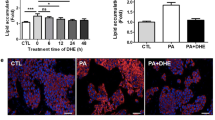Abstract
In this study, we aimed to study the role of growth factor receptor-bound protein 2 (Grb2) in palmitic acid-induced steatosis and other “fatty liver” symptoms in vitro. HepG2 cells, with or without stably suppressed Grb2 expression, were incubated with palmitic acid for 24 h to induce typical clinical “fatty liver” features, including steatosis, impaired glucose metabolism, oxidative stress, and apoptosis. MTT and Oil Red O assays were applied to test cell viability and fat deposition, respectively. Glucose uptake assay was used to evaluate the glucose utilization of cells. Quantitative polymerase chain reaction and Western blot were used to measure expressional changes of key markers of insulin signaling, lipid/glucose metabolism, oxidative stress, and apoptosis. After 24-h palmitic acid induction, increased fat accumulation, reduced glucose uptake, impaired insulin signaling, enhanced oxidative stress, and increased apoptosis were observed in HepG2 cells. Suppression of Grb2 in HepG2 significantly reduced fat accumulation, improved glucose metabolism, ameliorated oxidative stress, and restored the activity of insulin receptor substrate-1/Akt and MEK/ERK pathways. In addition, Grb2 deficiency attenuated hepatic apoptosis shown by reduced activation of caspase-3 and fluorescent staining. Modulation of Bcl-2 and Bak1 also contributed to reduced apoptosis. In conclusion, suppression of Grb2 expression in HepG2 cells improved hepatic steatosis, glucose metabolism, oxidative stress, and apoptosis induced by palmitic acid incubation partly though modulating the insulin signaling pathway.





Similar content being viewed by others
References
Burks D. J.; White M. F. IRS proteins and beta-cell function. Diabetes 50(Suppl 1): S140–145; 2001.
Howard B. V. Insulin resistance and lipid metabolism. Am. J. Cardiol. 84: 28J–32J; 1999.
Johmura S.; Oh-hora M.; Inabe K.; Nishikawa Y.; Hayashi K.; Vigorito E.; Kitamura D.; Turner M.; Shingu K.; Hikida M.; Kurosaki T. Regulation of Vav localization in membrane rafts by adaptor molecules Grb2 and BLNK. Immunity 18: 777–787; 2003.
Kondo A.; Hirayama N.; Sugito Y.; Shono M.; Tanaka T.; Kitamura N. Coupling of Grb2 to Gab1 mediates hepatocyte growth factor-induced high intensity ERK signal required for inhibition of HepG2 hepatoma cell proliferation. J. Biol. Chem. 283: 1428–1436; 2008.
Langlais P.; Dong L. Q.; Ramos F. J.; Hu D.; Li Y.; Quon M. J.; Liu F. Negative regulation of insulin-stimulated mitogen-activated protein kinase signaling by Grb10. Mol. Endocrinol. 18: 350–358; 2004.
Leto D.; Saltiel A. R. Regulation of glucose transport by insulin: traffic control of GLUT4. Nat. Rev. Mol. Cell Biol. 13: 383–396; 2012.
Li J. W.; Wang G. P.; Fan J. Y.; Chang C. F.; Xu C. S. Eight paths of ERK1/2 signalling pathway regulating hepatocyte proliferation in rat liver regeneration. J. Genet. 90: 435–442; 2011.
Liu X.; Liu M.; Zhang J.; Bai X.; Ramos F.; Van Remmen H.; Richardson A.; Liu F. Y.; Dong L. Q.; Liu F. Downregulation of Grb2 contributes to the insulin-sensitizing effect of calorie restriction. Am. J. Physiol. Endocrinol. Metab. 296: E1067–E1075; 2009.
Malaguarnera M.; Di Rosa M.; Nicoletti F.; Malaguarnera L. Molecular mechanisms involved in NAFLD progression. J. Mol. Med. 87: 679–695; 2009.
Mao X.; Kikani C. K.; Riojas R. A.; Langlais P.; Wang L.; Ramos F. J.; Fang Q.; Christ-Roberts C. Y.; Hong J. Y.; Kim R. Y.; Liu F.; Dong L. Q. APPL1 binds to adiponectin receptors and mediates adiponectin signalling and function. Nat. Cell. Biol. 8: 516–523; 2006.
Mazza A.; Fruci B.; Garinis G. A.; Giuliano S.; Malaguarnera R.; Belfiore A. The role of metformin in the management of NAFLD. Exp. Diabetes. Res. 2012: 716404; 2012.
Samuel V. T.; Shulman G. I. Mechanisms for insulin resistance: common threads and missing links. Cell 148: 852–871; 2012.
Schlessinger J. Cell signaling by receptor tyrosine kinases. Cell 103: 211–225; 2000.
Sowers J. R. Insulin resistance and hypertension. Am. J. Physiol. Heart Circ. Physiol. 286: H1597–1602; 2004.
Smith B. W.; Adams L. A. Non-alcoholic fatty liver disease. Crit. Rev. Clin. Lab. Sci. 48: 97–113; 2011.
Tiikkainen M.; Häkkinen A. M.; Korsheninnikova E.; Nyman T.; Mäkimattila S.; Yki-Järvinen H. Effects of rosiglitazone and metformin on liver fat content, hepatic insulin resistance, insulin clearance, and gene expression in adipose tissue in patients with type 2 diabetes. Diabetes 53: 2169–2176; 2004.
Wieckowska A.; Zein N. N.; Yerian L. M.; Lopez A. R.; McCullough A. J.; Feldstein A. E. In vivo assessment of liver cell apoptosis as a novel biomarker of disease severity in nonalcoholic fatty liver disease. Hepatology 44: 27–33; 2006.
Author information
Authors and Affiliations
Corresponding author
Additional information
Editor: T. Okamoto
Xiangxiang Shan and Yufeng Miao contributed equally to this work.
Electronic supplementary material
Below is the link to the electronic supplementary material.
ESM Fig. 1
Deficiency of Grb2 did not influence the fat accumulation and cell viability of untreated HepG2 cells. Representative pictures for Oil Red O staining of HepG2 cells of (A) control and (B) Grb2 suppression group. Quantification of Oil Red O signals was concluded in C. Cell viability was measured by MTT assay (D). Error bars represent standard error of the mean of samples within a group (n = 5). Magnification ×400. ns Not significant (JPEG 33 kb)
Rights and permissions
About this article
Cite this article
Shan, X., Miao, Y., Fan, R. et al. Suppression of Grb2 expression improved hepatic steatosis, oxidative stress, and apoptosis induced by palmitic acid in vitro partly through insulin signaling alteration. In Vitro Cell.Dev.Biol.-Animal 49, 576–582 (2013). https://doi.org/10.1007/s11626-013-9646-9
Received:
Accepted:
Published:
Issue Date:
DOI: https://doi.org/10.1007/s11626-013-9646-9




